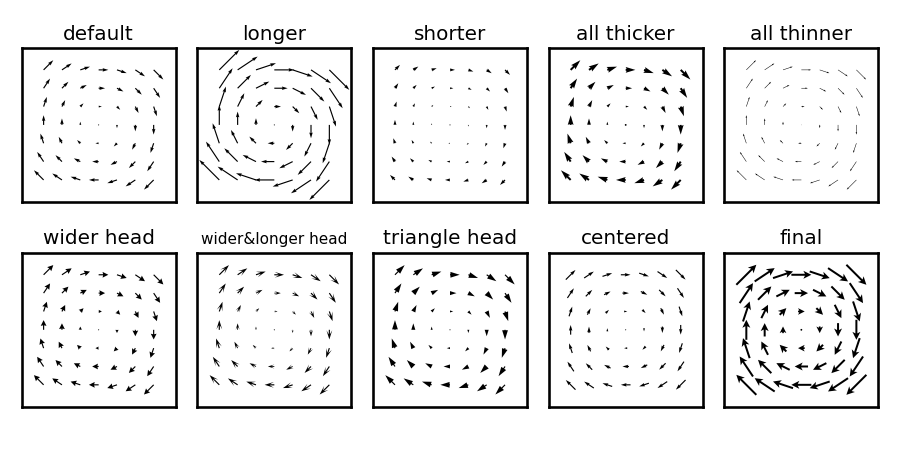はじめに
Pythonのmatplotlibにベクトル場を描画するquiver (クイバー) という関数があります。既定値のまま使う分には問題ありませんが、細かいパラメータ調節をしようとすると非常にやりづらいです。ヘルプを読めばちゃんと書いてありますが、理解するまでに時間がかかります。以下にコツを紹介します。
どうして難しいのか?
- 各用語が何を指すかが分からない
-
scaleが小さいほど矢印が長く、大きいほど短くなる -
widthの既定の単位がピクセルでない (適当に1とかに設定すると大惨事になる) -
widthを変えると、矢印の線の太さだけでなく矢印の先端部分も連動して変化する -
headwidth,headlength,headaxislengthはwidthに対する倍率で指定する -
headaxislengthがheadlengthと連動していない
解決法
- 各用語の意味は以下の図を参考にする

-
sclaleは、最大長の逆数の1.5倍で指定する (例、最大20ピクセルならunits='dots', scale=1.5/20) -
widthの単位はピクセルに変える (units='dots') - 先に
widthを決めた後でheadwidth,headlength,headaxislengthを調節する -
headwidth,headlength,headaxislengthの調節では、もし倍率指定が分かりにくければ、別変数を用意してピクセルで指定し、それらをwidthで割ってquiver関数に渡す -
headaxislengthはheadlengthと同じ値にするか (凹みなし)、0.9倍から0.8倍程度にする (凹みあり)
確認用コード
# 関連パッケージの読み込み
import numpy as np
import matplotlib.pyplot as plt
import seaborn as sns
sns.set_context('talk', font_scale=0.8)
# メイン関数
def test_quiver():
### 適当なベクトル場を作成 ###
# x軸とy軸
x_arr = np.linspace(-1, 1, 7) # -1から1まで等間隔に7点
y_arr = np.linspace(-1, 1, 7) # 同上
# 2次元の格子に変換
X ,Y = np.meshgrid(x_arr, y_arr)
# 極座標系に変換
R = (X**2 + Y**2)**0.5 # 原点からの距離
Q = np.angle(X + 1j * Y) # 角度 (複素数に変換して計算)
# 時計回りのベクトル場
U = R * np.sin(Q) # x成分
V = -R * np.cos(Q) # y成分
### 描画 ###
# fig, axの用意
fig, axes = plt.subplots(figsize=(9, 4.5), ncols=5, nrows=2)
axes = axes.flatten()
# 既定
ax = axes[0]
ax.quiver(X, Y, U, V)
ax.set_title('default')
# 長くする
ax = axes[1]
ax.quiver(X, Y, U, V, units='dots', scale=1.5/30)
ax.set_title('longer')
# 短くする
ax = axes[2]
ax.quiver(X, Y, U, V, units='dots', scale=1.5/7.5)
ax.set_title('shorter')
# 全体的に太くする
ax = axes[3]
ax.quiver(X, Y, U, V, units='dots', width=2)
ax.set_title('all thicker')
# 全体的に細くする
ax = axes[4]
ax.quiver(X, Y, U, V, units='dots', width=0.5)
ax.set_title('all thinner')
# 矢印の先端を太くする
ax = axes[5]
ax.quiver(X, Y, U, V, units='dots', headwidth=5)
ax.set_title('wider head')
# 矢印の先端を太く、長くする
ax = axes[6]
ax.quiver(X, Y, U, V, units='dots', headwidth=5, headlength=8)
ax.set_title('wider&longer head', fontsize=11)
# 矢印の先端を三角形にする
ax = axes[7]
ax.quiver(X, Y, U, V, units='dots', headwidth=5, headlength=8,
headaxislength=8)
ax.set_title('triangle head')
# 各矢印の中心 (長さ半分の位置) を座標点に合わせる
ax = axes[8]
ax.quiver(X, Y, U, V, pivot='mid')
ax.set_title('centered')
# 色々調節した完成形
ax = axes[9]
units = 'dots' # 単位をピクセルにする
arrow_length = 30 # 矢印の最大長
arrow_width = 2 # 矢印の太さ
head_length = 8 # 矢印の先端の長さ (固定長)
head_width = 8 # 矢印の先端の幅 (固定長)
head_dip = 0.2 # 矢印の先端の裏側の凹み具合 (0から0.2程度までを推奨)
kws = dict(units = units,
scale = 1.5 / arrow_length,
width = arrow_width,
headwidth = head_width / arrow_width,
headlength = head_length / arrow_width,
headaxislength = (1 - head_dip) * head_length / arrow_width)
ax.quiver(X, Y, U, V, pivot='mid', **kws)
ax.set_title('final')
# 共通設定
for ax in axes:
ax.set_xticks([]) # x軸の目盛りを消す
ax.set_yticks([]) # y軸の目盛りを消す
ax.set_aspect('equal') # 縦横比を1:1にする
ax.margins(0.2) # 描画範囲を少し拡大
# 余白を減らす
fig.tight_layout()
# 完成した図を表示
fig.show()
# ファイルに保存
fig.savefig('tmp.png')
